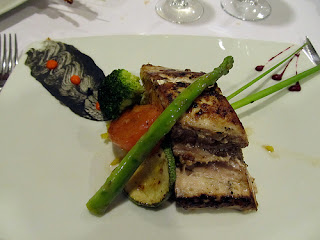If you’ve wondered why you’re seeing mahi mahi on so many restaurant menus these days, one of the reasons is a little trick that’s being played on you. Mahi mahi (Hawaiian for “strong-strong”) is just another name for the fish called dolphin. The restaurants have switched to the name “mahi mahi” so you won’t get confused and think they’re trying to serve you a slice of that mammal that is called dolphin. You wouldn’t like the idea of chowing down on Flipper (would you?).
Sometimes mahi mahi is hyphenated (“mahi-mahi”), and sometimes it goes by the alternative name, dorado. Whatever you choose to call it, this is a fish that has both great flavor and the nice, firm texture that most seafood lovers prefer.
Mahi mahi swim in many waters, but are found most abundantly in the warm Caribbean Sea and the Gulf of Mexico. Next time you dine on mahi mahi—or buy some from the supermarket—you can be confident that it probably came from one of those two bodies.
Fresh mahi mahi is generally available throughout the year, but, in North America at least, you will find the best selection in mid-spring through mid- to late-summer. You can also find frozen mahi mahi fillets all year round.
When buying fresh mahi mahi, look for fish whose meat is pink or light beige. Darker meat is certainly safe to eat, but the taste might be too strong for some people.
Mahi mahi is a great all-around fish for just about any cooking method you want to use. Poach it, steam it, fry it, bake it, grill it—it’s all good. Just be careful not to overcook it.
Here’s a recipe I particularly like for broiled mahi mahi. The zesty orange-juice glaze adds extra interest.
Ingredients
2 pounds mahi mahi fillets (skinless)
2 tablespoons prepared mustard
1/2 cup cooking oil
1/2 teaspoon salt
1 clove garlic, minced
1/2 cup frozen orange juice concentrate
1 bay leaf
Directions
1. Cut the mahi mahi fillets into serving size portions and place side by side in a baking dish.
2. Thaw the juice concentrate. Crumble the bay leaf. Combine these with the other remaining ingredients and mix well to create a marinade.
3. Pour the marinade over the mahi mahi (make sure you turn the fish to coat both sides).
4. Cover baking dish with plastic wrap and place in refrigerator for 30 to 43 minutes.
5. Place pan on top rack of oven and broil 5 or 6 minutes on each side. Fish will be ready when you can easily flake it with a fork.
6. Serve!
Sometimes mahi mahi is hyphenated (“mahi-mahi”), and sometimes it goes by the alternative name, dorado. Whatever you choose to call it, this is a fish that has both great flavor and the nice, firm texture that most seafood lovers prefer.
Mahi mahi swim in many waters, but are found most abundantly in the warm Caribbean Sea and the Gulf of Mexico. Next time you dine on mahi mahi—or buy some from the supermarket—you can be confident that it probably came from one of those two bodies.
Fresh mahi mahi is generally available throughout the year, but, in North America at least, you will find the best selection in mid-spring through mid- to late-summer. You can also find frozen mahi mahi fillets all year round.
When buying fresh mahi mahi, look for fish whose meat is pink or light beige. Darker meat is certainly safe to eat, but the taste might be too strong for some people.
Mahi mahi is a great all-around fish for just about any cooking method you want to use. Poach it, steam it, fry it, bake it, grill it—it’s all good. Just be careful not to overcook it.
Here’s a recipe I particularly like for broiled mahi mahi. The zesty orange-juice glaze adds extra interest.
Ingredients
2 pounds mahi mahi fillets (skinless)
2 tablespoons prepared mustard
1/2 cup cooking oil
1/2 teaspoon salt
1 clove garlic, minced
1/2 cup frozen orange juice concentrate
1 bay leaf
Directions
1. Cut the mahi mahi fillets into serving size portions and place side by side in a baking dish.
2. Thaw the juice concentrate. Crumble the bay leaf. Combine these with the other remaining ingredients and mix well to create a marinade.
3. Pour the marinade over the mahi mahi (make sure you turn the fish to coat both sides).
4. Cover baking dish with plastic wrap and place in refrigerator for 30 to 43 minutes.
5. Place pan on top rack of oven and broil 5 or 6 minutes on each side. Fish will be ready when you can easily flake it with a fork.
6. Serve!
Sarah Sandori is the food and entertaining columnist for the Solid Gold Info Writers Consortium. Have you ever wanted to be able to exactly duplicate a favorite dish from a favorite restaurant? Check out Sarah's article where she reveals her source for the most mouth-watering secret restaurant recipes in America: http://www.solid-gold.info/most-wanted-recipes.html
